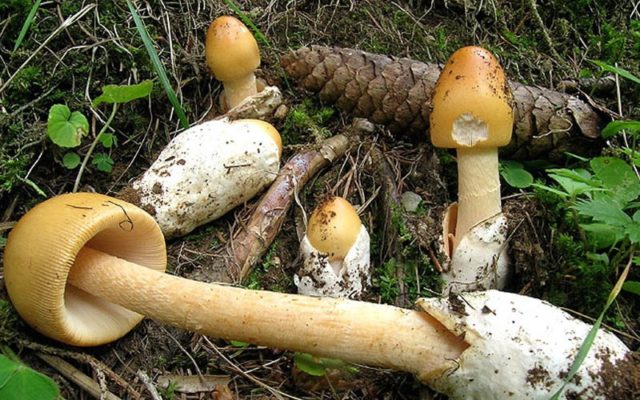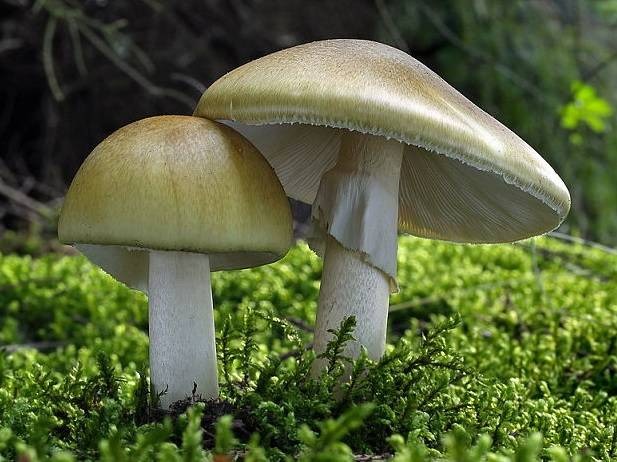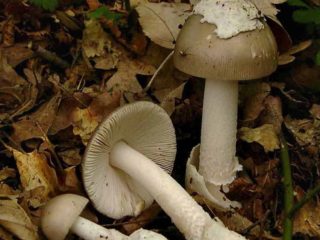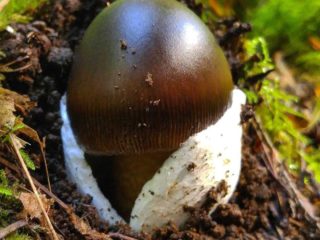Content
Saffron float (saffron float, saffron pusher) is one of the few representatives of the mushroom genus Amanita, suitable for food. This species can be found infrequently in our forests and, despite the fact that it is considered of little value from a culinary point of view, it has its fans.
What does a saffron float look like?
The appearance of the saffron float varies depending on age - young specimens are strong, stable, dense, while adults - with a fully opened cap on a thin stem - look fragile. Because of its appearance, many mushroom pickers consider it poisonous.
Description of the cap
The saffron float got its name because of the color and shape of the cap - it can have shades of orange-yellow with a brighter and more saturated center; Thanks to this color, the mushroom is clearly visible in the grass. The newly emerged saffron float has an ovoid cap; as it grows, it opens up, acquiring a hemispherical, bell-shaped shape. In adult specimens, the cap becomes flat with a small tubercle in the middle. In humid weather, its smooth, dry or slightly slimy surface acquires a characteristic shine. The cap on average reaches 40–80 mm in diameter, but in some cases it grows up to 130 mm.
With age, the frequent white plates become creamy or yellowish and appear along the edges of the cap, causing it to become ribbed. A small amount of Volva may remain on the surface.
Description of the leg
The saffron pusher has a smooth or scaly cylindrical leg, 60 to 120 mm long, 10–20 mm thick. At the base it is somewhat thicker than at the cap, and can be either straight or slightly curved. Color varies from pure white to saffron. The leg is hollow, brittle, without a ring, but the scales can form peculiar belts.
A peculiarity of this species of mushroom is the presence of a sac-like volva from which a stalk grows. In some cases it may be in the ground, but more often it is observed above its surface.
Where and how does it grow
In our latitudes, you can find the saffron float from the second half of summer to mid-autumn, mainly in those forests where deciduous trees grow - birch, beech, oak. It is also often adjacent to spruce. It feels best in lighted places: on the edges, along paths, in copses, and can grow in swampy areas. Prefers fertile, moist, acidic soils. It often grows solitarily, but can also occur in groups.
In our country, it is most common in the Far East, in the Primorsky Territory, and is well known to mushroom pickers in the Tula and Ryazan regions.
Is the mushroom edible or not?
Saffron float is classified as a conditionally edible mushroom, but from a culinary point of view its value is low, since the pulp does not have a distinct taste or smell and crumbles easily.
Like other conditionally edible species, saffron float requires preliminary boiling, which is best done twice, changing the water.
How to prepare saffron float
After preliminary boiling, the saffron float is fried, stewed or added to soups.
Many mushroom lovers do not agree that it is tasteless and share their recipes for preparing it. Some housewives suggest frying the mushroom until crispy without first boiling it. They claim that the taste of the finished dish with this method of preparation is somewhat reminiscent of the taste of chicken.
Many people prepare soups from this type of mushroom, and they also highly praise pickled saffron floats.
The taste of saffron pushers is often compared to the taste of corn - the flesh of young specimens is dense and sweetish. There are lovers of “quiet hunting” who value the taste of pushers higher than other, even the noblest mushrooms.
Poisonous doubles and their differences
The main danger when collecting saffron float is its resemblance to the deadly poisonous toadstool. The difference between these species is that the toadstool has a ring on the leg, while the float does not. There are no grooves along the edge of the cap of the pale grebe, like in adult pushers.
Also, the saffron float can easily be confused with the bright yellow fly agaric. The fruit bodies of these two varieties are very similar in shape and color.
You can distinguish one species from another by the following characteristics:
- the bright yellow fly agaric retains the remains of a coverlet on its cap, and the surface of the saffron float is most often smooth and clean. If there are any remains of the Volvo left on it, there are very few of them;
- the flesh of the bright yellow fly agaric has a distinct radish odor, while its edible counterpart has a faint mushroom aroma;
- the leg of the poisonous twin has a membranous ring. Even if it disappears over time, its trace still remains.
The saffron float is easily confused with other types of conditionally edible floats - orange and gray. The orange float looks more elegant, and its cap is colored in rich shades of orange.
The gray float is larger.Its flesh is stronger and fleshier, and the color of the cap can vary over a wide range: from light gray to grayish-ochre.
Another double of the saffron float is considered to be the Caesar (royal) mushroom or Caesar's fly agaric, which is considered an extremely valuable and tasty delicacy of the kingdom. Caesar's fly agaric is larger, has stronger flesh, and the smell contains notes of hazelnut. The cap can have shades from orange to fiery red, the leg and plates are also orange. A distinctive feature of Caesar's fly agaric is the presence of a ring on the stem, which floats do not have.
Conclusion
Saffron float is a mushroom of interest to sophisticated lovers of “quiet hunting”. Special care must be taken when collecting, as its counterparts are extremely dangerous. If you have the slightest doubt, you should refuse to collect saffron float and give preference to more well-known species.
















